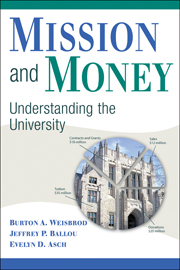Book contents
- Frontmatter
- Contents
- Illustrations
- Preface
- 1 An Introduction to the Higher Education Industry
- 2 The Higher Education Business and the Business of Higher Education – Now and Then
- 3 Is Higher Education Becoming Increasingly Competitive?
- 4 The Two-Good Framework: Revenue, Mission, and Why Colleges Do What They Do
- 5 Tuition, Price Discrimination, and Financial Aid
- 6 The Place of Donations in Funding the Higher Education Industry
- 7 Endowments and Their Management: Financing the Mission
- 8 Generating Revenue from Research and Patents
- 9 Other Ways to Generate Revenue – Wherever It May Be Found: Lobbying, the World Market, and Distance Education
- 10 Advertising, Branding, and Reputation
- 11 Are Public and Nonprofit Schools “Businesslike”? Cost-Consciousness and the Choice between Higher Cost and Lower Cost Faculty
- 12 Not Quite an Ivory Tower: Schools Compete by Collaborating
- 13 Intercollegiate Athletics: Money or Mission?
- 14 Mission or Money: What Do Colleges and Universities Want from Their Athletic Coaches and Presidents?
- 15 Concluding Remarks: What Are the Public Policy Issues?
- Appendix
- References
- Index
15 - Concluding Remarks: What Are the Public Policy Issues?
Published online by Cambridge University Press: 17 July 2009
- Frontmatter
- Contents
- Illustrations
- Preface
- 1 An Introduction to the Higher Education Industry
- 2 The Higher Education Business and the Business of Higher Education – Now and Then
- 3 Is Higher Education Becoming Increasingly Competitive?
- 4 The Two-Good Framework: Revenue, Mission, and Why Colleges Do What They Do
- 5 Tuition, Price Discrimination, and Financial Aid
- 6 The Place of Donations in Funding the Higher Education Industry
- 7 Endowments and Their Management: Financing the Mission
- 8 Generating Revenue from Research and Patents
- 9 Other Ways to Generate Revenue – Wherever It May Be Found: Lobbying, the World Market, and Distance Education
- 10 Advertising, Branding, and Reputation
- 11 Are Public and Nonprofit Schools “Businesslike”? Cost-Consciousness and the Choice between Higher Cost and Lower Cost Faculty
- 12 Not Quite an Ivory Tower: Schools Compete by Collaborating
- 13 Intercollegiate Athletics: Money or Mission?
- 14 Mission or Money: What Do Colleges and Universities Want from Their Athletic Coaches and Presidents?
- 15 Concluding Remarks: What Are the Public Policy Issues?
- Appendix
- References
- Index
Summary
At the heart of this book has been our examination of the distinction between what colleges and universities do to raise revenue and how they spend it to advance their missions. That distinction is neither simple nor clear. Raising money and spending it are interrelated, not distinct. Every one of the methods used by colleges and universities to raise funds for the support of their training, research, and public service missions has side effects that can easily compromise those missions. That conflict, or tension as we have called it, highlights the challenge to public policy on higher education: how to make it possible for colleges and universities to generate revenue in ways that minimize the side effects or distortionary effects on the mission, which is typically ill defined.
Complicated as that challenge is to deal with, it is only part of the overall public policy challenge for higher education. How much revenue “should” higher education have? How should the funds be spent? How many colleges and universities should there be? What should the mix of large and small schools be? Does higher education have the “right” balance of two-year community colleges and research universities, of career academies and traditional degree-granting schools, of residential and Internet-based programs? Is the combination of public, private nonprofit, and for-profit higher education “appropriate”? And although everyone would like to see “high-quality” education, what does that mean in practical terms?
- Type
- Chapter
- Information
- Mission and MoneyUnderstanding the University, pp. 278 - 294Publisher: Cambridge University PressPrint publication year: 2008

